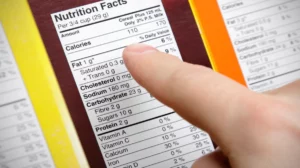In today’s fast-paced world, making informed choices about the food we eat has never been more important. Supermarket shelves are lined with countless products claiming to be healthy, organic, low-fat, or natural. But how can you cut through the marketing jargon and make decisions that are truly beneficial for your health? The answer lies in learning how to read and understand food labels.
Food labels provide a wealth of information that, when interpreted correctly, can help you choose foods that support your dietary goals and overall well-being. In this blog, we’ll break down the key components of food labels, explore what to look for, and offer research-based tips for making smarter food choices.

Understanding Food Labels: What to Look For
Food labels are designed to inform consumers about the nutritional content of the product and its ingredients. Here are the critical sections of food labels that you should focus on when making decisions:
1. Serving Size
The first place to start when reading a food label is the serving size, usually located at the top. The serving size tells you the amount of food that the nutritional information pertains to, and it may not always be what you expect. For example, a bag of chips may contain two or three servings, even though many people might eat the entire bag in one sitting.
Why it matters: According to the American Heart Association, being aware of serving sizes helps you accurately determine how many calories, fats, sugars, and other nutrients you are consuming. Misinterpreting serving sizes can lead to unintentional overeating.
2. Calories
Calories give you an estimate of the energy you’ll get from one serving. This is particularly important for those looking to manage their weight. However, it’s not just the number of calories that matters; it’s the source of those calories.
Why it matters: Research published in the New England Journal of Medicine shows that while calorie intake plays a role in weight management, the type of calories you consume (carbohydrates, proteins, fats) affects your metabolism and overall health. For instance, calories from highly processed sugars can spike blood sugar levels and contribute to insulin resistance.
3. Nutrients to Limit: Saturated Fat, Trans Fat, Cholesterol, and Sodium
The next section highlights nutrients that should be limited for better health. High intake of saturated fat, trans fat, cholesterol, and sodium is associated with an increased risk of chronic diseases like heart disease, hypertension, and stroke.
- Saturated Fat and Trans Fat: Both types of fats can raise LDL (bad) cholesterol levels and increase your risk of heart disease. The American Heart Association recommends keeping saturated fat to less than 10% of your total daily calories and avoiding trans fats entirely.
- Cholesterol: While dietary cholesterol does not affect blood cholesterol levels in most people, those with heart disease or high cholesterol should limit their intake.
- Sodium: Excessive sodium intake can lead to high blood pressure and increased cardiovascular risk. The CDC suggests limiting sodium to 2,300 milligrams per day for most adults.
4. Nutrients to Prioritize: Fiber, Vitamins, and Minerals
On the flip side, there are nutrients that many people don’t get enough of—fiber, calcium, iron, and vitamins A and C are examples. A diet rich in these nutrients supports good health and may reduce the risk of certain conditions such as osteoporosis, anemia, and heart disease.
- Dietary Fiber: Fiber is crucial for maintaining digestive health, regulating blood sugar levels, and lowering cholesterol. According to the Mayo Clinic, aim for at least 25-30 grams of fiber per day from a variety of sources, such as whole grains, fruits, and vegetables.
- Vitamins and Minerals: Calcium and vitamin D are important for bone health, while iron helps in the transport of oxygen in the blood. Vitamins A and C also play key roles in immune function and skin health.
5. Total Sugars and Added Sugars
One of the most crucial elements on modern food labels is the distinction between total sugars and added sugars. Total sugars refer to the combined amount of natural and added sugars in the product, while added sugars are those that are not naturally occurring but have been added during processing or preparation.
Why it matters: The World Health Organization (WHO) recommends limiting added sugars to less than 10% of total daily energy intake to prevent obesity, heart disease, and type 2 diabetes. A diet high in added sugars can contribute to weight gain and insulin resistance.
Conclusion
Shopping smart starts with understanding the information on food labels. By paying attention to serving sizes, calories, fat content, added sugars, and the ingredient list, you can make healthier and more informed decisions that align with your nutritional goals. Making small, consistent changes like focusing on whole foods, limiting processed items, and reading labels carefully can have a lasting positive impact on your health.
Be mindful of the food choices you make, and let the label guide you to better nutrition.



